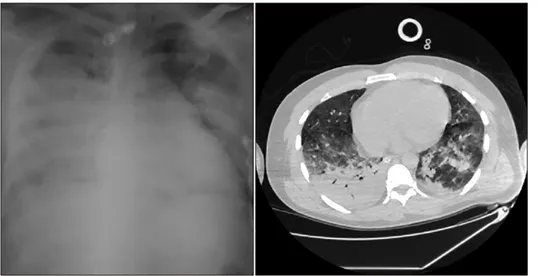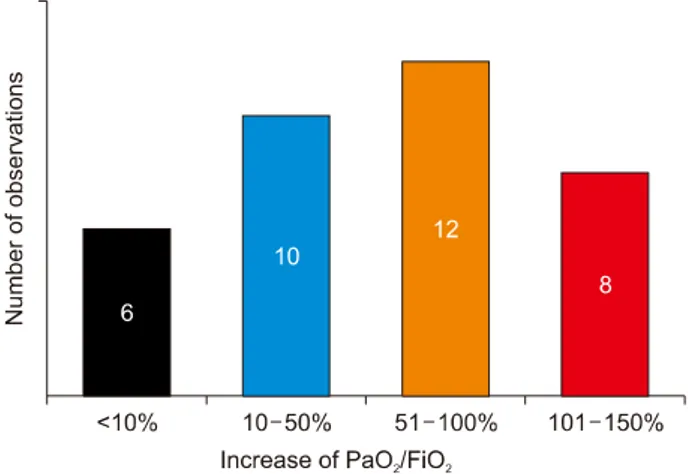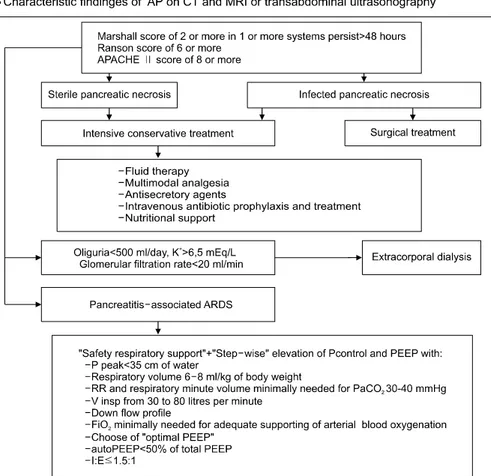Acute respiratory distress-syndrome in the general complications of severe acute pancreatitis
Ravshan Aliyevich Ibadov1, Anvar Shamkhatovich Arifjanov1,
Sardor Khamdamovich Ibragimov1, and Bakhrom Rustamjanovich Abdullajanov2
1Intensive Care Unit, Republican Specialized Scientific-Practical Medical Center of Surgery Named after Academician V.Vakhidov, Tashkent, 2Department of Surgery, Andijan State Medical Institute, Andijan, Uzbekistan
Backgrounds/Aims: Improvement of efficiency of treatment of patients with severe acute pancreatitis (SAP), complicated by acute respiratory distress-syndrome (ARDS). Methods: The retrospective research of 67 SAP patients treated at the ICU of the NSSPCS has been conducted from 2008 to 2017. The basic criterion of patient inclusion was stable respira- tion impairment leading to hypoxia with PaO2/FiO2<300 mmHg that required mechanical ventilatory support. Results:
Pancreatitis-associated ARDS was diagnosed in 36 cases (53.7%). The most frequent clinical form (15 cases) was ARDS of moderate severity (41.5%). The total mortality due to pancreatitis-associated ARDS made 44.5%. Close relation- ship between ARDS severity and mortality was evident. All lethal outcomes occurred due to progressing multiple organ dysfunction. No deaths were caused by uncontrollable hypoxemia. Conclusions: The research has confirmed the lead- ing role of pancreatitis-associated ARDS in development and high mortality rate of multiple organ dysfunction syndrome in SAP. Early recognition of the complication and application of ventilatory support techniques resulted in fast restora- tion of oxygenation and improvement of treatment efficiency. (Ann Hepatobiliary Pancreat Surg 2019;23:359-364) Key Words: Severe acute pancreatitis; Acute respiratory distress-syndrome; Intensive therapy; Respiratory support
Received: February 7, 2019; Revised: July 11, 2019; Accepted: July 25, 2019 Corresponding author: Ravshan Aliyevich Ibadov
Intensive Care Unit, Republican Specialized Scientific-Practical Medical Center of Surgery Named after Academician V.Vakhidov, 10 Kichik Halka Yuli str, Tashkent 100115, Uzbekistan
Tel: +998903279289, Fax: +998903279289, E-mail: dr.sardor.ibragimov@gmail.com
Copyright Ⓒ 2019 by The Korean Association of Hepato-Biliary-Pancreatic Surgery
This is an Open Access article distributed under the terms of the Creative Commons Attribution Non-Commercial License (http://creativecommons.org/
licenses/by-nc/4.0) which permits unrestricted non-commercial use, distribution, and reproduction in any medium, provided the original work is properly cited.
Annals of Hepato-Biliary-Pancreatic Surgery ∙ pISSN: 2508-5778ㆍeISSN: 2508-5859
INTRODUCTION
Acute pancreatitis (AP) remains to be one of widely spread surgical illnesses of the gastrointestinal system. It is known to be characterized by high mortality rate, in its destructive forms in particular, which varies from 10%
to 85%.1,2
AP necrotic forms develop due to various purulent- septic and systemic complications being the principal cause of unsatisfactory immediate results of treatment of pa- tients with severe AP (SAP).3,4 SAP complications, as a rule, create a situation for a physician when the disease course become spoorly controlled, and the outcome is hard- ly predicted.
Multiple organ dysfunction syndrome (MODS) is an in- tegral part of SAP complications, and pancreatitis-associated acute respiratory distress-syndrome (ARDS) indicates the
earliest organ dysfunction in SAP. According to various investigators, ARDS death toll makes 25-80%.5-8
The basic part of intensive therapy for pancreatitis-asso- ciated ARDS is timely started and adequately performed respiratory support. It is obvious, that the success can be achieved only with the earliest possible prediction of the complication and correct selection of the complex treat- ment tactics using modern methods of respiratory therapy.9
MATERIALS AND METHODS
Ethical approval
The review board and ethics committee of RSSPMCS named after acad. V.Vakhidov approved the study proto- col and informed consents were taken from all the parti- cipants.
The research was designed on the basis of management
Fig. 1. The initial X-ray and CT-scan of the chest of 48-year old patient with SAP compli- cated with pancreatitis-associated ARDS of moderate severity.
of 67 SAP patients at the NSSPCS in 2008-2017. It in- cluded the analyses of frequency of development of pan- creatitis-associated ARDS and the complication clinical course as well as evaluation of the intensive therapy effi- ciency and outcomes.
The diagnosis criteria and assessment of AP severity were based on the third revision of the Atlanta-92 interna- tional classification (2012).2 The diagnosis of ARDS was made according to the standard criteria, i.e. acute onset, bilateral opacities on chest imaging (chest radiograph or CT), a decrease in the PaO2/FiO2 index below 300 mmHg, no signs of left ventricle failure as the principal cause of gas exchange disorder. We used the Berlin definition of ARDS (2012) made by the Conciliatory Commission “The ARDS Definition Task Force”.9 In the present research, the cases which till 2012 were interpreted as “acute lung injury” were included in the mild ARDS category.
To verify the initial diagnosis and trace the subsequent development of pancreatitis-associated ARDS, computer tomography was used in addition to X-ray films, that demonstrated the areas of reduced ventilation of the lungs due to consolidation of the pulmonary tissue (Fig. 1).
The complex intensive therapy for pancreatitis-associated ARDS was based on respiratory support performed ac- cording to the principles of “safe ventilation” and applica- tion of a step-wise technique of increasing P-control and PEEP values. It included:
- the peak pressure in the respiratory tract – ≤35 cmH2O;
- the respiratory volume - no greater than 6-8 ml/kg of body weight;
- the minimum respiration frequency and ventilation vol-
ume per minute necessary for keeping PaCO2 at the level of 30-40 mmHg;
- the velocity of the peak inspiration flow ranging from 30-40 to 70-80 L/min;
- the inspiration flow profile - descending (ramped);
- the minimum oxygen fraction in the respiratory gas necessary for sufficient oxygenation of arterial blood and oxygen transport to tissues;
- PEEP values corresponding to “the optimum PEEP”
concept with the maximum oxygen transport to tissues;
- selection of auto-PEEP to avoid high auto-PEEP: <50%
of the total PEEP;
- the inspiration pauses duration (IP): <30% of the du- ration of the respiratory cycle;
- the inspiration/expiration ratio inverting not more than 1.5:1;
- a sedative therapy and if it is necessary – short myo- plegia. Avoid hyperventilation.
To achieve the set goals VELLA (Viasys Healthcare Inc.) and “Puritan Bennett 840” (General Electric, USA) were used. At the stage of the expressed impairment of gas exchange, respiratory support was used in CMV, SIMV, BIPAP, PSpatterns; preference was given to the pressure- control.
Noninvasive ventilation was carried out in NiCPAP and NiSIMV modes. The initial level of support by inspiratory pressure (Pinsp) was 7 cmH2O with the subsequent in- crease up to achievement of respiratory volume of 6-8 ml/
kg of due body weight. In addition, mechanical intra- pulmonary percussive ventilation (IPV) with IPV-HCBI- PHASICIMPULSATOR (Percussionaire) was carried out.
Fig. 2. Distribution of observations depending on the PaO2/ FiO2 gain next day after the initiation of respiratory support.
Constant pressure in the airways was kept at the level of 5- 10 cmH2O, the respiration support pressure was 5-15 cmH2O.
The following indicators were registered: Ppeak, Pinsp, Pplat, PEEP, respiratory system compliance (Crs), static compliance (Cst) and resistance of the respiratory system (Rrs). The PEEP optimum value was determined by in- dicators of respiratory mechanics, oxygenation and by the analysis of the pressure-volume curve. On the inspiratory part of the curve, the upper and lower bend points were verified.
The the respiratory therapy efficiency was evaluated by the following criteria: paO2/FiO2>300 mmHg, a decrease in blood shunting (from right to left), pO2 (A-a) e, pO2
(a-A) e, reduction of the infiltration on the chest X-ray, dynamically increasing static compliance (Cst), restoration of cough-reflex.
RESULTS
In our research, 36 (12.4%) SAP patients had pancreatitis- associated ARDS. In 11 (30.5%) cases, ARDS was severe;
moderate severity ARDS was diagnosed in 15 (41.7%) cases, and 10 (27.8 %) patients had mild ARDS. On the average, the initial paO2/FiO2 index was 155±65 mmHg.
Probability of ARDS development increased in elder patients (over 50 years). Other significant risk factors are SAP purulent-septic complications, intra-abdominal hy- pertension that necessitated surgical operations at the ini- tial or final stages, as well as infusion of high doses of catecholamine immediately after the surgery. All patients required from 5- to 25-day mechanical ventilation (MV).
Respiratory support efficiency in all 36 clinically ob- served pancreatitis-associated ARDS was evaluated by the change in PaO2/FiO2values registered on the following day after MV initiation. The PaO2/FiO2 gain was calcu- lated in percentage to the initial value, and the calculated value could be both positive (oxygenation improvement) and negative (oxygenation deterioration). Distribution of observations depending on respiratory support efficiency is presented in Fig. 2. The respiratory support with the paO2/FiO2 gain below 10% (in 6 patients) was considered in efficient. In these patients, ARDS developed as a com- ponent of MODS or sepsis. MV continuation was not ac- companied by significant improvement of gas exchange;
the paO2/FiO2 index has been 150-250 mmHg for a long
time necessitating prolongation of respiratory support with PEEP above 10 cm H2O and FiO2 above 50%. These pa- tients died due to progressing MODS. Among 36 patients with pancreatitis-associated ARDS, lethal outcomes oc- curred in 16 cases; thus, the death rate in the study group made 44.5%.
However, we noticed the tendency to a greater gain of the PaO2/FiO2 index in the cases with early application of respiratory therapy.
We have found out a regular relation between the se- verity of the syndrome and mortality rate. For instance, the above mentioned lethal outcomes were caused by moderate and severe pancreatitis-associated ARDS, pro- gressing MODS with accompanied by acute cardiovas- cular failure at the terminal stage. In addition, over 50%
of SAP patients had two and more purulent-septic compli- cations.
In 20 (55.5 %) patients, the intensive therapy with res- piratory support has led to satisfactory results with reso- lution of pancreatitis-associated ARDS and improvement of the patient general condition. The changes in the in- dicators of gas exchange and respiration biomechanics re- sulted from the technique of a “step-wise” increase in PEEP and P-control are presented in Table 1.
Significant improvement of the indices under study (PaO2 and PaO2/FiO2) contributing to reduction of FiO2
was revealed. It enabled to apply supportive artificial lung ventilation (ALV) to provide spontaneous breathing activ- ity of the patients. In addition, some positive dynamics in oxygen alveolar-arterial (P(A-a)O2) and arterial-alveolar differences (P(a-А)O2) as well as the degree of intrapul-
Table 1. Dynamics of average indices of gas exchange during respiratory therapy for pancreatitis-associated ARDS Measurement Initially 12 h later 24 h later 36 h later 48 h later 60 h later 72 h later
PaO2, mmHg 93.6 99.6 112.7 126.7 130.4 141.5 147
PaCO2, mmHg 36.7 34.8 35.5 37.8 38.1 41.4 42.3
PaO2/FiO2, mmHg 156 166 205 230.4 260.8 283 294
P(A-a)O2, mmHg 24 24 22 20 16 13 13
P(a-A)O2, mmHg 140 135 135 120 110 95 80
Qs/Qt 38 35 33 32 29 26 25
SvO2, % 63.6 64.8 65.7 72.4 74 73.2 71
Lactate, mmol/L 2.44 1.84 1.62 1.65 1.71 1.68 1.5
Fig. 3. The X-ray and CT-scan- ning of the chest of 48-year old patient after 72 hours of respi- ratory support.
monary shunting (Qs/Qt) were observed. The modes of pressure-controlled respiratory support did not decline car- diac efficiency and oxygen delivery to tissues judging by the absence of SvO2 negative dynamics and lactate con- centration in venous blood.
The X-ray and MSCT showed considerable reduction in the infiltration areas and improvement of the lung pat- tern (Fig. 3).
In 12 patients, IPV and NiCPAP were applied at the stage of transition from traditional ALV through an endo- tracheal tube to spontaneous breathing activity. As a re- sult, we noted a considerable decrease in the duration of invasive ALV in comparison with the cases where the technique was not applied.
Thus, the analysis of the gas exchange indicators has confirmed that it is possible to maintain adequate oxygen- ation using respiratory support in the modes of pres- sure-controlled "step-wise" technique of increasing PEEP and P-control.
DISCUSSION
Summing up the clinical and retrospective data, it is possible to draw a conclusion that pancreatitis-associated ARDS is the leading cause of MODS development in SAP and high mortality associated with it. According to the literature data, pancreatitis-associated ARDS causes 60% of all cases of death in SAP within the first week of the disease.7 Currently, SAP patient management is based on an intensive conservative therapy. It is aimed at prevention of specific complications using a supporting therapy, reduction in severity of inflammation and ne- crosis of the pancreas to avoid the progress of the syn- drome of systemic inflammatory response.4,10,11
Almost half a century period of studying the features of ARDS treatment enables to formulate the conceptual framework: 1) respiratory support is a basis of the ARDS intensive therapy; 2) respiratory support per se can dam- age the lungs and aggravate the course of the disease; 3) the tactics of respiratory support in ARDS should be
Fig. 4. Algorithm for the man- agement of SAP.
individualized.12
When carrying out an ARDS respiratory therapy, gen- erally accepted requirements are observing the “safe ven- tilation” concept and keeping the alveoli open.12 Applica- tion of modern technologies of respiratory support with selection of ventilation optimum parameters can reduce the number of infectious-inflammatory complications in SAP patients related to ALV.
According to the results of the research, the medical- tactical algorithm of SAP patient management has been proposed (Fig. 4). It is based on evaluating and prognostic scales, application of the entire complex of medical tactics that provides the maximum opportunities for SAP intensive conservative therapy and respiratory support in pancreatitis- associated ARDS.
Pancreatitis-associated ARDS is still an urgent clinical problem in intensive therapy for severe AP due to high incidence and mortality. Early clinical manifestations of pancreatitis-associated ARDS are occult and necessitate the dynamic control of the most objective indicators of
gas exchange, daily analysis of the prognostic scales, ap- plication of modern methods of diagnosis and respiratory support.
The combination of concepts of “safe ventilation” and
“safe hypoxemia” with application of the “step-wise” tech- nique of increasing P-control and PEEP results in faster restoration of oxygenation, shorter invasive respiratory support, significant reduction in frequency of ventilator- associated pneumonia.
IPV used at the stage of transition to spontaneous breathing activity reliably makes noninvasive ALV short- er, accelerates activation of patients and reduces the dura- tion of their stay in an ICU.
ACKNOWLEDGEMENTS
This work was supported by Republican specialized scientific-practical medical center of surgery named after academician V.Vakhidov, Tashkent, Uzbekistan.
REFERENCES
1. Tonsi AF, Bacchion M, Crippa S, Malleo G, Bassi C. Acute pan- creatitis at the beginning of the 21st century: the state of the art. World J Gastroenterol 2009;15:2945-2959.
2. Banks PA, Bollen TL, Dervenis C, Gooszen HG, Johnson CD, Sarr MG, et al.; Acute Pancreatitis Classification Working Group.
Classification of acute pancreatitis--2012: revision of the Atlanta classification and definitions by international consensus. Gut 2013;
62:102-111.
3. Büchler MW, Gloor B, Müller CA, Friess H, Seiler CA, Uhl W.
Acute necrotizing pancreatitis: treatment strategy according to the status of infection. Ann Surg 2000;232:619-626.
4. Wada K, Takada T, Hirata K, Mayumi T, Yoshida M, Yokoe M, et al. Treatment strategy for acute pancreatitis. J Hepatobiliary Pancreat Sci 2010;17:79-86.
5. Buter A, Imrie CW, Carter CR, Evans S, McKay CJ. Dynamic nature of early organ dysfunction determines outcome in acute pancreatitis. Br J Surg 2002;89:298-302.
6. Pastor CM, Matthay MA, Frossard JL. Pancreatitis-associated
acute lung injury: new insights. Chest 2003;124:2341-2351.
7. Zhou MT, Chen CS, Chen BC, Zhang QY, Andersson R. Acute lung injury and ARDS in acute pancreatitis: mechanisms and po- tential intervention. World J Gastroenterol 2010;16:2094-2099.
8. Zhao X, Andersson R, Wang X, Dib M, Wang X. Acute pan- creatitis-associated lung injury: pathophysiological mechanisms and potential future therapies. Scand J Gastroenterol 2002;37:
1351-1358.
9. ARDS Definition Task Force, Ranieri VM, Rubenfeld GD, Thompson BT, Ferguson ND, Caldwell E, et al. Acute respira- tory distress syndrome: the Berlin Definition. JAMA 2012;307:
2526-2533.
10. Cruz-Santamaría DM, Taxonera C, Giner M. Update on patho- genesis and clinical management of acute pancreatitis. World J Gastrointest Pathophysiol 2012;3:60-70.
11. Hirota M, Takada T, Kitamura N, Ito T, Hirata K, Yoshida M, et al. Fundamental and intensive care of acute pancreatitis. J Hepatobiliary Pancreat Sci 2010;17:45-52.
12. Rittayamai N, Brochard L. Recent advances in mechanical ven- tilation in patients with acute respiratory distress syndrome. Eur Respir Rev 2015;24:132-140.



